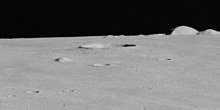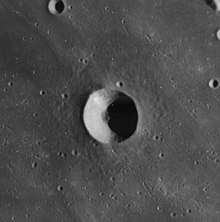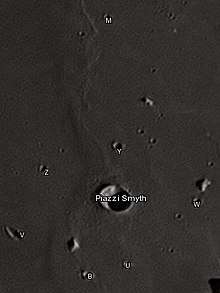Piazzi Smyth (crater)
Piazzi Smyth is a small lunar impact crater in the eastern part of the Mare Imbrium. It was named after Scottish astronomer Charles Piazzi Smyth.[1] This is an isolated feature located about 100 kilometers to the southwest of the Montes Alpes mountain range. To the southeast of this crater is Mons Piton, an isolated mountain that rises to a height of 2.3 km and occupies a diameter of about 25 km.

 Lunar Orbiter 4 image | |
| Coordinates | 41.9°N 3.2°W |
|---|---|
| Diameter | 13 km |
| Depth | 2.5 km |
| Colongitude | 3° at sunrise |
| Eponym | Charles Piazzi Smyth |
This crater is a nicely circular feature with a rim and interior that have not been significantly modified by impacts. The inner walls slope smoothly downwards to the small floor about the midpoint, which occupies a diameter of only one-fifth the total diameter of the crater. This formation has no other notable features, and its albedo matches the surrounding lava plain.
Satellite craters

By convention these features are identified on lunar maps by placing the letter on the side of the crater midpoint that is closest to Piazzi Smyth.
| Piazzi Smyth |
Latitude | Longitude | Diameter |
|---|---|---|---|
| B | 40.5° N | 3.4° W | 4 km |
| M | 45.0° N | 4.2° W | 2 km |
| U | 40.8° N | 2.7° W | 3 km |
| V | 40.9° N | 4.7° W | 7 km |
| W | 42.2° N | 1.9° W | 3 km |
| Y | 42.8° N | 3.4° W | 4 km |
| Z | 42.1° N | 4.6° W | 3 km |
References
- "Piazzi Smyth (crater)". Gazetteer of Planetary Nomenclature. USGS Astrogeology Research Program.
- Andersson, L. E.; Whitaker, E. A. (1982). NASA Catalogue of Lunar Nomenclature. NASA RP-1097.CS1 maint: ref=harv (link)
- Bussey, B.; Spudis, P. (2004). The Clementine Atlas of the Moon. New York: Cambridge University Press. ISBN 978-0-521-81528-4.CS1 maint: ref=harv (link)
- Cocks, Elijah E.; Cocks, Josiah C. (1995). Who's Who on the Moon: A Biographical Dictionary of Lunar Nomenclature. Tudor Publishers. ISBN 978-0-936389-27-1.CS1 maint: ref=harv (link)
- McDowell, Jonathan (July 15, 2007). "Lunar Nomenclature". Jonathan's Space Report. Retrieved 2007-10-24.CS1 maint: ref=harv (link)
- Menzel, D. H.; Minnaert, M.; Levin, B.; Dollfus, A.; Bell, B. (1971). "Report on Lunar Nomenclature by the Working Group of Commission 17 of the IAU". Space Science Reviews. 12 (2): 136–186. Bibcode:1971SSRv...12..136M. doi:10.1007/BF00171763.CS1 maint: ref=harv (link)
- Moore, Patrick (2001). On the Moon. Sterling Publishing Co. ISBN 978-0-304-35469-6.CS1 maint: ref=harv (link)
- Price, Fred W. (1988). The Moon Observer's Handbook. Cambridge University Press. ISBN 978-0-521-33500-3.CS1 maint: ref=harv (link)
- Rükl, Antonín (1990). Atlas of the Moon. Kalmbach Books. ISBN 978-0-913135-17-4.CS1 maint: ref=harv (link)
- Webb, Rev. T. W. (1962). Celestial Objects for Common Telescopes (6th revised ed.). Dover. ISBN 978-0-486-20917-3.CS1 maint: ref=harv (link)
- Whitaker, Ewen A. (1999). Mapping and Naming the Moon. Cambridge University Press. ISBN 978-0-521-62248-6.CS1 maint: ref=harv (link)
- Wlasuk, Peter T. (2000). Observing the Moon. Springer. ISBN 978-1-85233-193-1.CS1 maint: ref=harv (link)
| Wikimedia Commons has media related to Piazzi Smyth (crater). |